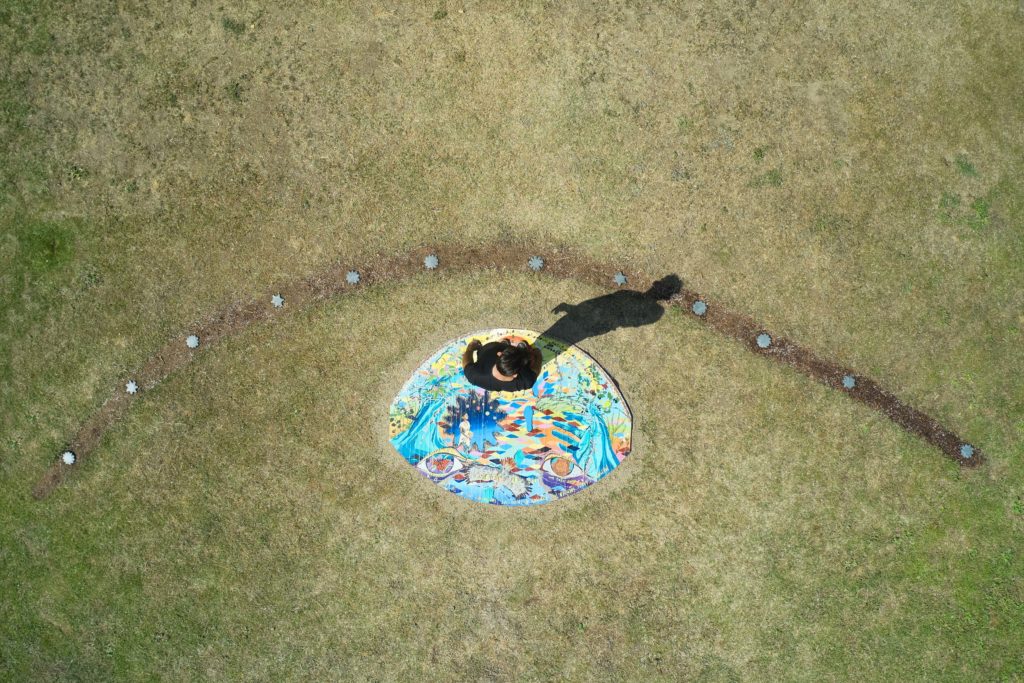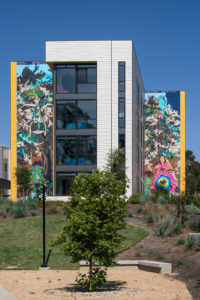
[ID: Overhead view of a collaborative human sundial installed at the LA State Historic Park by Julia Bogany, Megan Dorame, and iris yirei hu: Pakook koy Peshaax (The Sun Enters the Earth and Leaves the Earth), 2021. There is one person standing on the colorful sundial and casting a shadow onto the grass.]
I found love in the palm of my hand.
My fingers reach into a primordial, interconnected web of memory that manifests tangibly in the landscapes I have traversed. When I interact with the natural world, I notice the myriad of transformative relations that have consistently depended on one another season after season: the scrub jay who buries acorns to seed oak trees, the symbiosis between the chaparral yucca and their moth pollinator (Tegeticula maculata), and the common yarrow, whose tiny clouds of white flowers decorate the foothills and whose leaves can be chewed to make a poultice. The primordial is both abstract—far away and dispersed throughout multitudes of lifetimes—yet embodied and alive right in front of me. When I inhale, the sacred registers discernibly in my body. I feel it to be love.
When I use my hands to work with fibers, paint, or soil, I feel closest to these infinite nodes of brilliance. Through practice, I’ve arrived at the questions that drive my work: how do our hands and the stories they carry bridge presumed gaps between seemingly disparate things, and also help us understand one another? How can we understand history as generations of people cultivating love and optimism through deep relation, instead of a sequence of violent events?
For the last four years until her sudden passing, Tongva Elder Julia Bogany and I worked together to create intersecting spaces where Indigenous and immigrant peoples could explore possibilities of kinship. Elder Julia Bogany’s advocacy and teaching is grounded in the question: “I always say Tongva women never left their ancestral homeland, they just became invisible. ‘How do we make ourselves not invisible?’ is the question I ask every day.” The Tongva community, whose ancestral homeland encompasses the Los Angeles basin and parts of Orange County, have been working individually and collectively to build community and work through the atrocities they have endured from three eras of colonization — Spanish, Mexican, and American. Because the Spanish mission system was so heavily involved in the disintegration of organizing power within the local tribes, followed by the genocide committed by the American government, much of the culture, stories, identity, belonging, work, advocacy for visibility, advocacy for state and federal recognition, advocacy for collective health and healing, rests only in the hands of individual tribal members. That means when one tribal elder leaves us, the loss is felt as one that is beyond their lifetime. Generations of story, language, and song leave with them, too. Ms. Bogany was one of the most vocal, inviting, and accessible elders of her tribe and believed so deeply in collaborative life-making: when you work with and invite others in, we would be profoundly transformed and nourished by the abundance that exists in Southern California and beyond.
Ms. Bogany has given me the gift of possibility and optimism through her fight for social justice and for the revitalization of Southern California Indigenous legacy. She has taught me what love and resistance can look like with the power of art. Ms. Bogany worked to ensure that the future of her culture, people, and language are bountiful and accessible to generations to come. As an artist, I worked with her to process and provide solutions to her quest through visual art, facilitation, and creating platforms for visibility. Much of our work together centered the question: How can we, as residents of and visitors to Los Angeles take care of the land upon which we walk while caring for one another in ways that uplift the Indigenous legacy of Southern California and honor the multilayered, complex and contradictory histories of immigration? Notable examples of our shared work include: Lessons from Wise Woman (Tongva Elder Julia Bogany), Grandmother Oak Tree, and Hands (2018), an installation inspired by Ms. Bogany’s tireless advocacy for the San Gabriel Mission to openly acknowledge the gravity of its crimes against California’s Indigenous; a site-specific 47 ft. tall mural of Ms. Bogany at CSU Dominguez Hills (2020); and most recently in May 2021, Pakook koy Peshaax (The Sun Enters the Earth and Leaves the Earth), a human sundial made in collaboration with poet Megan Dorame (Tongva).

[ID: A colorful mural on the exterior of a student housing complex at CSU Dominguez Hills with Tongva Elder Julia Bogany sitting under an oak tree containing her grandmother’s spirit, and accompanied by native California plants and animals. She is birthing a butterfly, who symbolizes her great-granddaughter.]
It is from working closely with Ms. Bogany, in heart and in hand, and from experiencing the natural world as a living body that I derive my method of practice called collaborative optimism. Grounded by the many historical and ongoing traumas faced by Indigenous, Black, and people of color, collaborative optimism aims to world joy, friendship, kinship, and gathering into our shared realities. The practice emerges from the care for and guidance from the historically dispossessed of the land upon which it is practiced. Its function is to create opportunities for intercultural relationship building in its most embodied sense, and uplifts the various proximities to and embodiments of class, education, racial, and gender privileges its practitioners have access to, to center the healing of BIPOC communities and urgent land-based issues. Because being in deep relation requires time, reflection, and learning, the immediate politicization of difference in both culture and activism sectors, coupled with the pressure of visibility and speed to formulate a legible result under capitalist frameworks (i.e. social media, funding opportunities, and marketing campaigns), the nuanced practice of cultivating long-term and long-form collaboration is challenging. Collaborative optimism requires willing participants who value our connections across the world, and who understand that learning and fumbling are necessary steps towards the liberation of living beings and to whom we’re related. How can collaborative optimism shape land restitution and economic justice through artful stewardship and healing? Given each of our strengths, gifts, and pathways of access, how can we leverage our privileges to organize both local and international struggles so that each of us and those connected to us can access wellness, healing, beauty, and joy in the ways that we determine?
The multitude of lines flow, cross, and split across my palms. Each year I’ve noticed new lines form and creases deepen. I wonder what kind of map they form when placed next to another’s hand. I imagine that beauty, however self-determined or molded with collective agency, will journey alongside us in limning another atlas with grace.
For more information about Tongva Elder Julia Bogany, please visit her website: tobevisible.org.
This article appeared in the Winter 2022 issue of In Dance.

